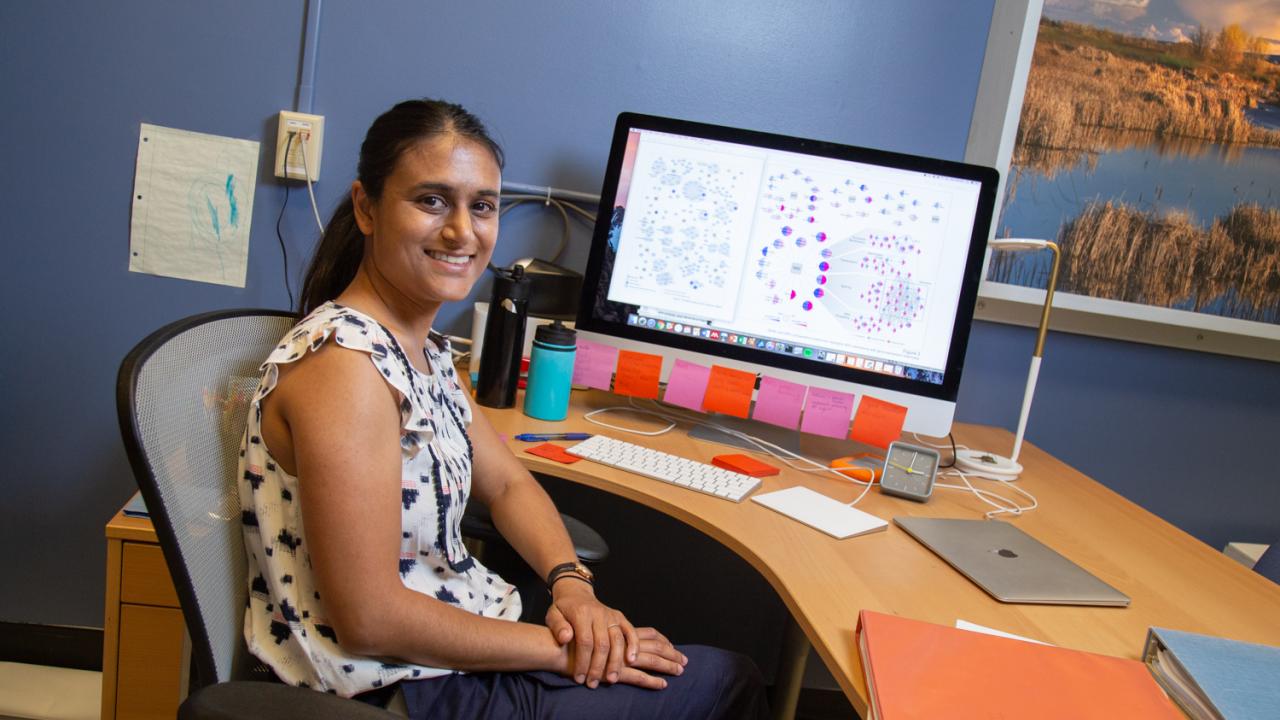
Discovering Curiosity: How Parenthood Informed Priya Shah’s Fundamental Virology Research
Quick Summary
- Priya Shah uses viruses as windows into cell biology
- Studying flaviviruses, like Zika and dengue, her lab uses synthetic biology methods to understand how viruses hijack cells
- She's launched projects to study virsues in model organisms like zebrafish and fruit flies
After the birth of her second child in February 2017, Priya Shah took some time off from her postdoctoral lab work in fundamental virology at UC San Francisco. Shah, who earned a Ph.D. in chemical engineering from UC Berkeley, spent about eight weeks at home with her newborn son. Not only was it an important time for the burgeoning relationship between mother and child, it was an important time for Shah’s science. Between the busy tasks of childrearing, she found time to comb through papers recently published in her field.
“If I hadn’t taken time from the lab to take care of my newborn, I wouldn’t have had the time to actually do the reading and reflect on what are the most interesting directions to take my research,” said Shah, now an assistant professor who holds joint appointments in the Department of Chemical Engineering and Department of Microbiology and Molecular Genetics. “I would have been in the lab, doing experiments that I thought might get me a quick answer as opposed to really digging into the literature and finding something very unique.”
The new perspective shaped the direction of Shah’s current research—studying how flaviviruses, like Zika and dengue, hijack biological processes in hosts to proliferate and spread. Her work could further our understanding of how flaviviruses lead to diseases, like dengue fever, or cause birth defects, like microcephaly in newborns.
“Understanding how these viruses replicate is really important because there are no therapies available to treat dengue and Zika virus infections or prevent their infections,” said Shah.
Members of the Shah Lab view viruses as windows into cell biology. They use systems biology to understand how viruses hijack cells and synthetic biology tools to try and create novel methods to control biological networks susceptible to viral infection. The hope is to discover new ways to stave off virus-driven diseases and congenital defects, which can be prevalent in developing countries.
“Having those sort of therapeutic avenues or prophylactic treatments would be very valuable, especially if you’re a woman in one of these countries and are thinking about starting a family,” said Shah.

The viral factory
Flaviviruses are mainly transmitted to humans via ticks and mosquitos. After feasting on our blood, these arthropods leave more than just bites behind—they inject viral travelers into us. Zika virus can also be transmitted between humans sexually.
For a virus to replicate and spread, it must first enter a host’s cell. Once inside, the virus produces daughter viruses that exit the cell and spread to neighboring cells, again and again and again, aggressively spreading through the organism.
“Viruses often use host proteins that are in the cell already, which do a lot of work for them,” said Shah. “So they essentially hijack these processes and make the cell into a little viral factory.”
By co-opting a host proteins’ natural functions, a virus can accelerate its infection range, causing not only disease in the original host organism but defects in the host organism’s offspring. The Shah Lab studies this process at the cellular level using the Zika virus.
“We’re using animal models, like fruit flies, to study microcephaly,” said Shah, noting a research project she’s working on with Hugo Bellen, of the Baylor College of Medicine.
But Shah isn’t only using flies for her research. She’s also using zebrafish, and that work was recently funded by the UC Davis Center for Comparative Medicine.
Virology through the eyes of an engineer
When Shah joined the UC Davis faculty in July 2017, she found herself in an advantageous situation. Not only did she attain joint appointments in the College of Engineering and the College of Biological Sciences, she found collaboration and interdisciplinary research a hallmark of the UC Davis experience. If she had questions about fundamental biology, helpful experts were within walking distance.
That’s how she partnered with Associate Professor Bruce Draper, Department of Molecular and Cellular Biology. Draper uses zebrafish as model organisms to study the genetics of sexual reproduction and disease development.
“What’s nice about zebrafish is they’re easy to study and manipulate, just like fruit flies, but they’re also vertebrates, so they’re a little bit closer to humans than flies are,” said Shah.

Zebrafish are transparent for their first few days of life, which makes them literal windows into organism development without the need for dissection. This allows Shah to observe microcephaly phenotypes as they’re developing.
While Shah isn’t an animal biologist, scaling up her experiments to zebrafish felt like a familiar concept. Part of a chemical engineer’s job is taking a chemical process and scaling it up to the industrial level, according to Shah.
“When I look zebrafish, I think, ‘Wow, I can take all of this data that I’ve generated in my lab using petri dishes and cells and I can actually scale it up to a whole organism,’” Shah said.
